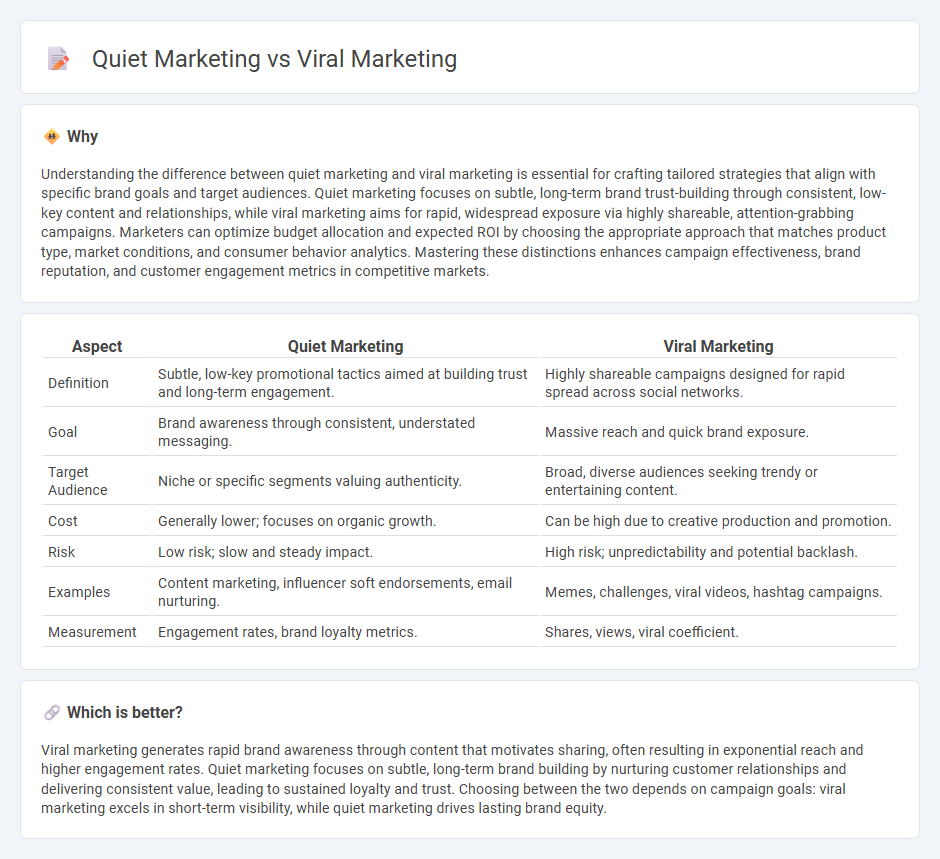
Quiet marketing emphasizes subtle brand presence through consistent, low-key strategies that build trust and loyalty over time, targeting niche audiences with personalized content. Viral marketing leverages high-impact, shareable content to rapidly increase brand awareness and engagement, often resulting in exponential reach within a short period. Discover more about how these contrasting approaches can transform your marketing strategy.
Why it is important
Understanding the difference between quiet marketing and viral marketing is essential for crafting tailored strategies that align with specific brand goals and target audiences. Quiet marketing focuses on subtle, long-term brand trust-building through consistent, low-key content and relationships, while viral marketing aims for rapid, widespread exposure via highly shareable, attention-grabbing campaigns. Marketers can optimize budget allocation and expected ROI by choosing the appropriate approach that matches product type, market conditions, and consumer behavior analytics. Mastering these distinctions enhances campaign effectiveness, brand reputation, and customer engagement metrics in competitive markets.
Comparison Table
| Aspect | Quiet Marketing | Viral Marketing |
|---|---|---|
| Definition | Subtle, low-key promotional tactics aimed at building trust and long-term engagement. | Highly shareable campaigns designed for rapid spread across social networks. |
| Goal | Brand awareness through consistent, understated messaging. | Massive reach and quick brand exposure. |
| Target Audience | Niche or specific segments valuing authenticity. | Broad, diverse audiences seeking trendy or entertaining content. |
| Cost | Generally lower; focuses on organic growth. | Can be high due to creative production and promotion. |
| Risk | Low risk; slow and steady impact. | High risk; unpredictability and potential backlash. |
| Examples | Content marketing, influencer soft endorsements, email nurturing. | Memes, challenges, viral videos, hashtag campaigns. |
| Measurement | Engagement rates, brand loyalty metrics. | Shares, views, viral coefficient. |
Which is better?
Viral marketing generates rapid brand awareness through content that motivates sharing, often resulting in exponential reach and higher engagement rates. Quiet marketing focuses on subtle, long-term brand building by nurturing customer relationships and delivering consistent value, leading to sustained loyalty and trust. Choosing between the two depends on campaign goals: viral marketing excels in short-term visibility, while quiet marketing drives lasting brand equity.
Connection
Quiet marketing leverages subtle, low-key promotion techniques to build trust and authenticity, laying the foundation for organic audience engagement. Viral marketing capitalizes on this trust by encouraging rapid content sharing, amplifying brand visibility through user-driven dissemination. Both strategies focus on creating genuine connections that inspire consumers to spread the message naturally, maximizing reach without overt advertising.
Key Terms
**Viral marketing:**
Viral marketing leverages social media platforms and influencer networks to rapidly increase brand exposure through shareable content that drives high user engagement and organic reach. This strategy often relies on emotional appeal, trending topics, and interactive campaigns to create buzz and encourage users to disseminate the message widely. Discover how viral marketing can amplify your brand's visibility and accelerate growth.
Word-of-mouth
Viral marketing leverages rapid, widespread sharing of content to create buzz, while quiet marketing emphasizes subtle, organic word-of-mouth growth through genuine customer experiences. Word-of-mouth marketing boosts trust and brand loyalty by encouraging authentic recommendations from satisfied customers, often resulting in higher conversion rates compared to paid advertising. Discover how strategic word-of-mouth can elevate your marketing efforts effectively.
Shareability
Viral marketing thrives on high shareability through emotionally charged content and widespread social media engagement, rapidly amplifying brand visibility. Quiet marketing leverages subtle, trust-building strategies such as influencer endorsements and niche targeting to foster long-term consumer loyalty. Explore detailed comparisons and practical tips to optimize your marketing strategy.
Source and External Links
Viral Marketing: What It Is and How It Works + Successful Examples - Viral marketing is a strategy aimed at making content spread rapidly among users, relying on creativity and emotional impact to encourage active audience participation and organic sharing, differing from traditional advertising by its participatory and exponential distribution.
Viral marketing - Wikipedia - Viral marketing uses existing social networks to promote products by leveraging consumer sharing that mimics viral infection, often through social media, and can take many forms like videos, games, or messages to create wide, rapid distribution mainly without direct paid promotion.
Viral Marketing: Advantages, Disadvantages, Examples and FAQs - Viral marketing harnesses captivating and share-worthy content to efficiently spread messages via social media and word-of-mouth, aiming for exponential reach through voluntary sharing motivated by the content's appeal and emotional connection.
 dowidth.com
dowidth.com